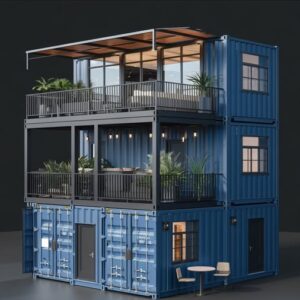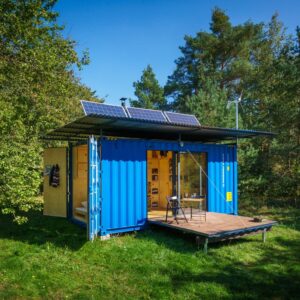How to Build a Shipping Container Home on a Budget – Top eBooks to Guide You
Building a shipping container home doesn’t have to cost a fortune! With the right strategies, you can create a stylish, sustainable home on a tight budget—think $10,000 to $20,000 for a 20ft container home. At Shipping Container Homes Book, I’ve put together this guide to help you save money while building your dream container home. Plus, I’ll share some of the best eBooks, including “Shipping Container Homes Made Easy”, to guide you every step of the way. Let’s get started!

Step 1: Set a Realistic Budget
First, decide how much you can spend. A 20ft shipping container home typically costs $10,000-$20,000, while a 40ft one might run $20,000-$40,000, depending on finishes. I budgeted $15,000 for my 20ft project and stuck to it by planning ahead. Add 10-15% for unexpected costs like permit fees ($500-$2,000 in the U.S.) or delivery charges ($500-$1,500). Use a free budgeting app like Mint to track expenses and avoid overspending.
Step 2: Buy an Affordable Shipping Container
The container is your biggest upfront cost, so shop smart. A used 20ft container can cost as little as $1,500, while a “one-trip” container (used once) runs $2,000-$4,000. I saved $600 by buying a used container on Craigslist—just make sure to inspect it for rust, dents, or chemical smells. Avoid overpaying by checking local suppliers or sites like eBay. If you’re on a tight budget, a used container is the way to go, but don’t skimp on quality!

Step 3: Minimize Foundation Costs
Your foundation doesn’t have to be expensive. Concrete piers ($1,000-$2,000) are cheaper than a full slab ($3,000-$5,000) and work well on uneven land. I went with piers for my rural lot and did the site prep myself—clearing debris and leveling the ground with a rented compactor ($50/day). This saved me $500 in labor costs. Choose a flat site with good drainage (check FEMA flood maps) to avoid future issues.
Step 4: DIY as Much as Possible
Labor costs can eat up your budget, so roll up your sleeves! I saved $2,000 by cutting windows and doors myself using a rented plasma cutter ($100/day). Reinforce cuts with steel beams (about $200) to keep the structure solid. For insulation, use affordable fiberglass batts ($500 for a 20ft container) instead of pricier spray foam. Watch free YouTube tutorials to learn basic skills like framing or drywall installation—it’s easier than you think!
Step 5: Source Cheap Materials Locally
Don’t splurge on fancy finishes. I found reclaimed wood for my walls at a local salvage yard for $300—half the price of new lumber. Check Craigslist or Habitat for Humanity ReStores for discounted flooring, windows, and fixtures. For plumbing, PEX pipes are budget-friendly ($500-$1,000 for a small setup). I also skipped a traditional HVAC system and installed a mini-split unit ($1,500), which cut my energy bills by 25%.
Step 6: Skip Non-Essentials and Go Off-Grid
Focus on must-haves like insulation and utilities, and skip extras like custom decks or high-end appliances. I saved $1,000 by delaying my deck build until next year. Going off-grid can also save money—solar panels ($2,000-$5,000) and a composting toilet ($500) eliminate utility bills. These options are increasingly popular in the U.S. for sustainable living, especially in rural areas.
Step 7: Use eBooks to Guide Your Build
Building on a budget is easier with the right resources. That’s where eBooks come in—they’re affordable and packed with expert advice. One of my favorites is “Shipping Container Homes Made Easy”, a ClickBank eBook priced at $47. It offers step-by-step plans, blueprints, and video tutorials that helped me save time and avoid costly mistakes. The eBook also includes tips on sourcing cheap materials and navigating U.S. permits, which was a lifesaver for my project. It’s perfect for beginners and even covers off-grid options like solar power and food growing.
Other great eBooks to consider include:
- “Container Home Blueprint Basics”: A $29 guide with simple plans for small container homes.
- “DIY Tiny Container Homes”: Priced at $35, this eBook focuses on budget builds under $15,000.

Step 8: Final Inspections on a Budget
Don’t skip inspections—they ensure your home is safe and legal. Hire a local inspector ($200-$500) and apply for an occupancy permit ($100-$1,000, varies by state). I saved $300 by scheduling my inspection early and fixing minor issues myself, like adding a fire extinguisher ($20). Once approved, you’re ready to move in!
Start Building Your Budget Container Home Today!
Building a shipping container home on a budget is totally doable with careful planning and the right resources. By following these steps, I turned a 20ft container into a cozy home for just $14,500—and you can too! If you’re ready to get started, I highly recommend “Shipping Container Homes Made Easy”. It’s packed with budget-friendly tips and blueprints to make your project a breeze. Grab your copy here and start building your dream home today!


